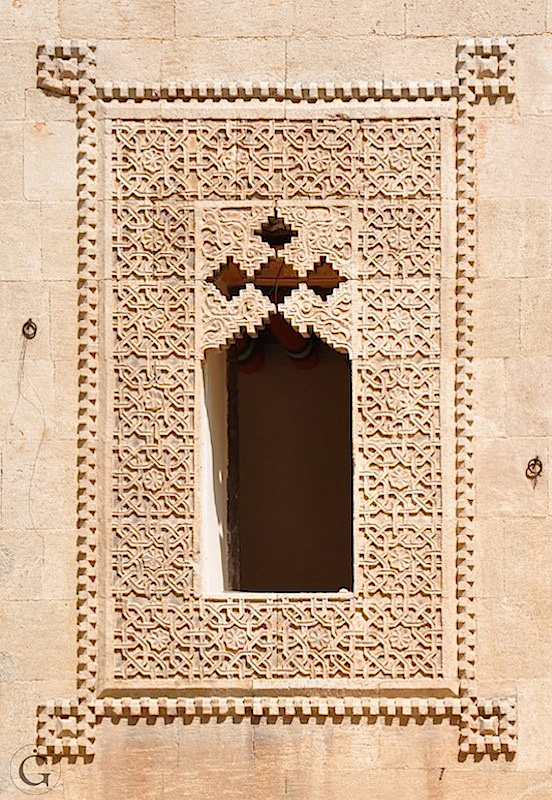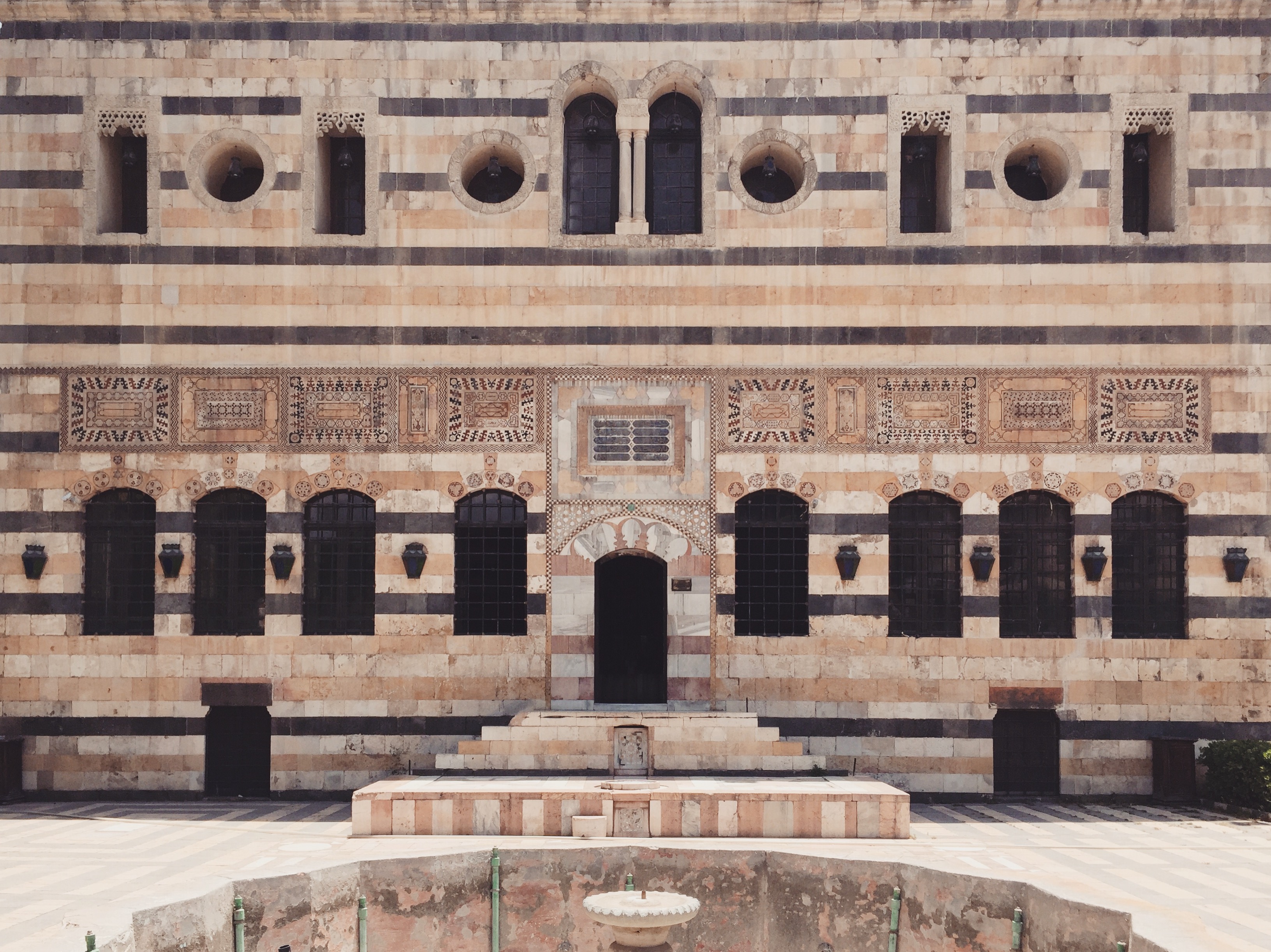|
Beit Ghazaleh
Beit Ghazaleh (The Ġazaleh House; ar, غزالة) is one of the largest and better-preserved palaces from the Ottoman period in Aleppo. It was named after the Ghazaleh family that owned it for about two centuries. Since 1914, it was used as a public school and was recently restored to host the Memory Museum of the city of Aleppo. Beit Ghazaleh is located in the Al-Jdayde district of Aleppo. History: the origins of the Ġazaleh House in Aleppo The house is located on the Western edge of a large suburb inhabited by a multi-religious and multi-ethnic population. This neighbourhood to the North of the old city of Aleppo developed since the late Mameluke period. This area became the Christian quarter of Jdeideh which was organically clustered around its churches. Here lived the notables of Aleppo's Christian communities, notably the Armenians who specialised in trade with India and Persia. The Ġazaleh House was built in front of two large Muslim waqfs — created in 1 ... [...More Info...] [...Related Items...] OR: [Wikipedia] [Google] [Baidu] |
Aleppo
)), is an adjective which means "white-colored mixed with black". , motto = , image_map = , mapsize = , map_caption = , image_map1 = , mapsize1 = , map_caption1 = , pushpin_map = Syria#Mediterranean east#Asia#Syria Aleppo , pushpin_label_position = left , pushpin_relief = yes , pushpin_mapsize = , pushpin_map_caption = Location of Aleppo in Syria , coordinates = , subdivision_type = Country , subdivision_name = , subdivision_type1 = Governorate , subdivision_type2 = District , subdivision_type3 = Subdistrict , subdivision_name1 = Aleppo Governorate , subdivision_name2 = Mount Simeon (Jabal Semaan) , subdivision_name3 = Mount Simeon (Ja ... [...More Info...] [...Related Items...] OR: [Wikipedia] [Google] [Baidu] |
Polychrome
Polychrome is the "practice of decorating architectural elements, sculpture, etc., in a variety of colors." The term is used to refer to certain styles of architecture, pottery or sculpture in multiple colors. Ancient Egypt Colossal statue of Tutankhamun Paris 2019 A.jpg, Polychrome quartzite colossal statue of Tutankhamun, 1355-1315 BC Nofretete Neues Museum.jpg, Polychrome limestone and plaster ''Bust of Nefertiti'', 1352–1336 BC Composite Papyrus Capital MET 10.177.2 EGDP018080.jpg, Polychrome sandstone Composite papyrus capital, 380–343 BC Medinet Habu 2016-03-23g.jpg, Polychrome winged sun on a cavetto from the Medinet Habu temple complex, unknown date Classical world Some very early polychrome pottery has been excavated on Minoan Crete such as at the Bronze Age site of Phaistos. In ancient Greece sculptures were painted in strong colors. The paint was frequently limited to parts depicting clothing, hair, and so on, with the skin left in the natur ... [...More Info...] [...Related Items...] OR: [Wikipedia] [Google] [Baidu] |
Al-Mutanabbi
Abū al-Ṭayyib Aḥmad ibn al-Ḥusayn al-Mutanabbī al-Kindī ( ar, أبو الطيب أحمد بن الحسين المتنبّي الكندي; – 23 September 965 AD) from Kufa, Abbasid Caliphate, was a famous Abbasid-era Arab poet at the court of the Hamdanid emir Sayf al-Dawla in Aleppo, and for whom he composed 300 folios of poetry. His poetic style earned him great popularity in his time and many of his poems are not only still widely read in today's Arab world but are considered to be proverbial. He started writing poetry when he was nine years old. He is well known for his sharp intelligence and wittiness. Among the topics he discussed were courage, the philosophy of life, and the description of battles. As one of the greatest, most prominent and influential poets in the Arabic language, much of his work has been translated into over 20 languages worldwide. His great talent brought him very close to many leaders of his time, whom he extolled in return for money and ... [...More Info...] [...Related Items...] OR: [Wikipedia] [Google] [Baidu] |
Transom (architectural)
In architecture, a transom is a transverse horizontal structural beam or bar, or a crosspiece separating a door from a window above it. This contrasts with a mullion, a vertical structural member. Transom or transom window is also the customary U.S. word used for a transom light, the window over this crosspiece. In Britain, the transom light is usually referred to as a fanlight, often with a semi-circular shape, especially when the window is segmented like the slats of a folding hand fan. A prominent example of this is at the main entrance of 10 Downing Street, the official residence of the British prime minister. History In early Gothic ecclesiastical work, transoms are found only in belfry unglazed windows or spire lights, where they were deemed necessary to strengthen the mullions in the absence of the iron stay bars, which in glazed windows served a similar purpose. In the later Gothic, and more especially the Perpendicular Period, the introduction of transoms became co ... [...More Info...] [...Related Items...] OR: [Wikipedia] [Google] [Baidu] |
Psalm 91
Psalm 91 is the 91st psalm of the Book of Psalms, beginning in English in the King James Version: "He that dwelleth in the secret place of the most High shall abide under the shadow of the Almighty." In Latin, it is known as 'Qui habitat". As a psalm of protection, it is commonly invoked in times of hardship. Though no author is mentioned in the Hebrew text of this psalm, Jewish tradition ascribes it to Moses, with David compiling it in his Book of Psalms. The Septuagint translation attributes it to David. In the slightly different numbering system used in the Greek Septuagint and Latin Vulgate translations of the Bible, this psalm is Psalm 90. The psalm forms a regular part of Jewish, Catholic, Eastern Orthodox, Lutheran, Anglican and other Protestant liturgies. The complete psalm and selected verses have often been set to music, notably by Heinrich Schütz and Felix Mendelssohn, who used verses for his motet '' Denn er hat seinen Engeln befohlen''. The psalm has been paraphrase ... [...More Info...] [...Related Items...] OR: [Wikipedia] [Google] [Baidu] |
Ablaq
Ablaq ( ar, أبلق; particolored; literally 'piebald') is an architectural technique involving alternating or fluctuating rows of light and dark stone. Records trace the beginnings of this type of masonry technique to the southern parts of Syria. It is associated as an Arabic term, especially as related to Arabic Islamic architectural decoration. The first recorded use of the term ''ablaq'' pertained to repairs of the Great Mosque of Damascus in 1109, but the technique itself was used much earlier. Technique This technique is a feature of Islamic architecture. The ablaq decorative technique is thought to maybe be a derivative from the ancient Byzantine Empire, whose architecture used alternate sequential runs of light colored ashlar stone and darker colored orange brick. The first known use of the term ablaq in building techniques is in masonry work in reconstruction improvements to the walls of the Umayyad Mosque of Damascus. According to records, these reconstruction m ... [...More Info...] [...Related Items...] OR: [Wikipedia] [Google] [Baidu] |
Palazzo Ghazaleh 3 1
A palace is a grand residence, especially a royal residence, or the home of a head of state or some other high-ranking dignitary, such as a bishop or archbishop. The word is derived from the Latin name palātium, for Palatine Hill in Rome which housed the Imperial residences. Most European languages have a version of the term (''palais'', ''palazzo'', ''palacio'', etc.), and many use it for a wider range of buildings than English. In many parts of Europe, the equivalent term is also applied to large private houses in cities, especially of the aristocracy; often the term for a large country house is different. Many historic palaces are now put to other uses such as parliaments, museums, hotels, or office buildings. The word is also sometimes used to describe a lavishly ornate building used for public entertainment or exhibitions such as a movie palace. A palace is distinguished from a castle while the latter clearly is fortified or has the style of a fortification, whereas a pa ... [...More Info...] [...Related Items...] OR: [Wikipedia] [Google] [Baidu] |
Qubba
A ''qubba'' ( ar, قُبَّة, translit=qubba(t), pl. ''qubāb''), also transliterated as ḳubba, kubbet and koubba, is a cupola or domed structure, typically a tomb or shrine in Islamic architecture. In many regions, such as North Africa, the term ''qubba'' commonly the tomb of a local ''wali'' (local Muslim saint) or marabout, and usually consists of a chamber covered by a dome or pyramidal cupola. Etymology The Arabic word qubba was originally used to mean a tent of hides, or generally the assembly of a material such as cloth into a circle. It's likely that this original meaning was extended to denote domed buildings after the latter had developed in Islamic architecture. It is now also used generally for tomb sites if they are places of pilgrimage. In Turkish and Persian the word ''kümbet'', ''kumbad'', or ''gunbād'' has a similar meaning for dome or domed tomb. Historical development A well-known example of an Islamic domed shrine is the Dome of the Rock, known in ... [...More Info...] [...Related Items...] OR: [Wikipedia] [Google] [Baidu] |
Iwan
An iwan ( fa, ایوان , ar, إيوان , also spelled ivan) is a rectangular hall or space, usually vaulted, walled on three sides, with one end entirely open. The formal gateway to the iwan is called , a Persian term for a portal projecting from the facade of a building, usually decorated with calligraphy bands, glazed tilework, and geometric designs. Since the definition allows for some interpretation, the overall forms and characteristics can vary greatly in terms of scale, material, or decoration. Iwans are most commonly associated with Islamic architecture; however, the form is Iranian in origin and was invented much earlier and fully developed in Mesopotamia around the third century CE, during the Parthian period of Persia. Etymology ''Iwan'' is a Persian word which was subsequently borrowed into other languages such as Arabic and Turkish. Its etymology is unclear. A theory by scholars like Ernst Herzfeld and W. B. Henning proposed that the root of this term ... [...More Info...] [...Related Items...] OR: [Wikipedia] [Google] [Baidu] |




.jpg)




.jpg)